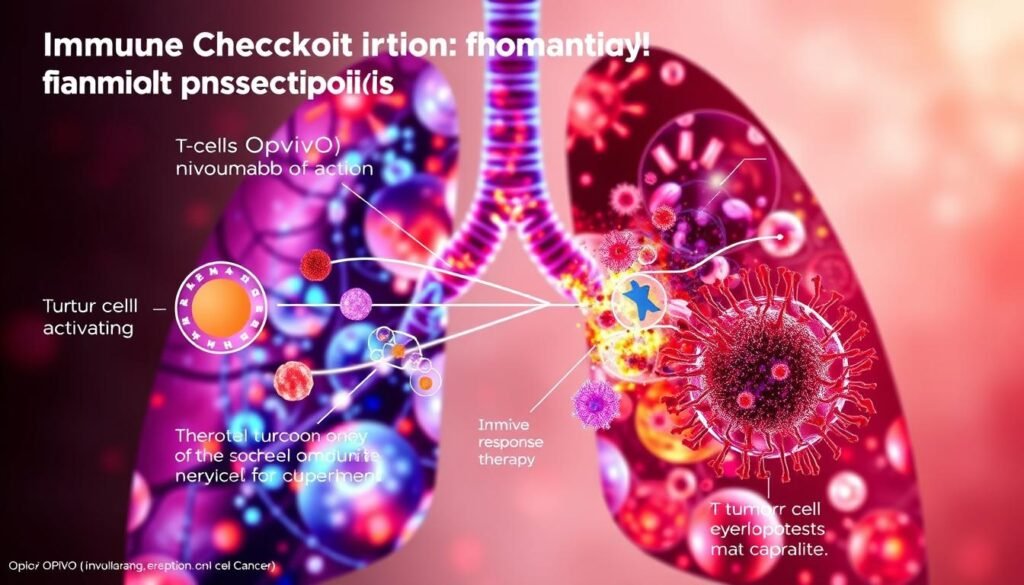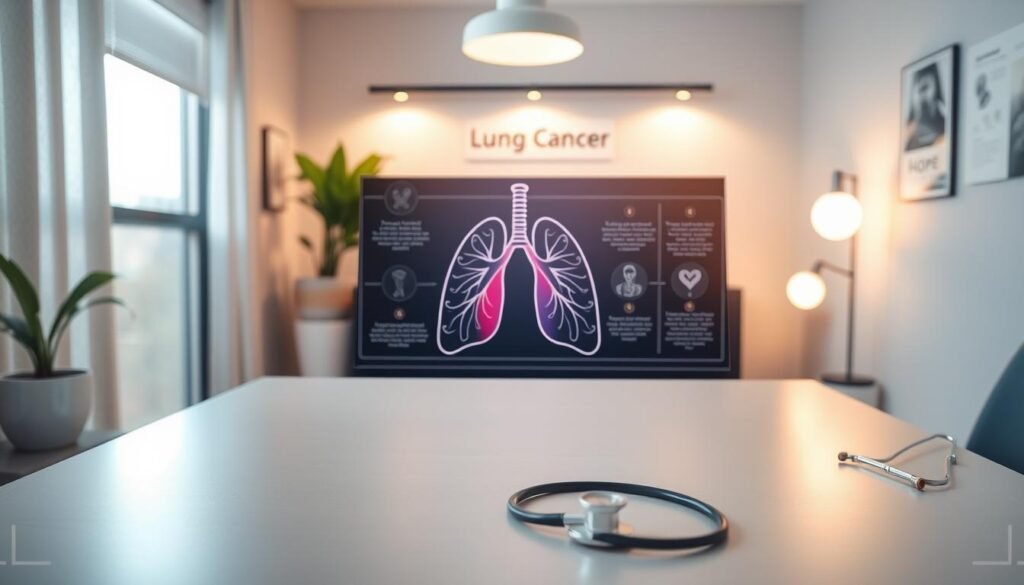Did you know the five-year survival rate for small cell lung cancer (SCLC) is under 10%? This cancer is tough to beat, often hitting older people and those who’ve smoked. Opdivo, or nivolumab, is a beacon of hope in cancer treatment. It’s important for both patients and doctors to understand its benefits for SCLC.
This guide gives you the full scoop on Opdivo. You’ll learn how it works, how it’s used, the doses needed, its side effects, and the latest research. Knowing about Opdivo can help improve treatment for lung cancer. For dosing details, check out the official dosing page.
Key Takeaways
- Opdivo (nivolumab) is a key drug in cancer immunotherapy for small cell lung cancer.
- Using Opdivo with chemo is a major approach for advanced lung cancer.
- Knowing signs and symptoms of small cell lung cancer helps with early treatment.
- It’s crucial to watch for immune reactions with Opdivo.
- Clinical trials are always underway to find more uses for Opdivo in SCLC treatment.
Understanding Small Cell Lung Cancer
Small cell lung cancer (SCLC) grows quickly and is often found in smokers. It accounts for about 15% of all lung cancer cases. These cancers multiply fast, leading to large tumors and spreading early.
Most people find out they have SCLC when it has spread throughout the body. This makes treatment hard. Knowing about this type of cancer is key to managing it. Traditional treatments include chemotherapy and radiation. Now, there are also new options like immunotherapy.
- Chemotherapy can work up to 70% of the time, but the cancer often comes back.
- Imaging tests, like chest X-rays, are important for finding SCLC and seeing how it changes.
- New treatments approved by the FDA, such as Tarlatamab-dlle (Imdelltra) and Nivolumab (Opdivo), are helping fight advanced SCLC.
There is no easy way to find SCLC early. It’s important to know the signs and risks to catch it fast. The fight against this cancer is ongoing, but research brings hope for better treatments.
What is Opdivo?
Opdivo, also called nivolumab, is a type of drug known as a monoclonal antibody. It falls under the group of drugs called immune checkpoint inhibitors. By blocking the PD-1 pathway, Opdivo helps the immune system spot and destroy cancer cells. Approved for several cancers like melanoma and lung cancer, Opdivo is a big step forward in cancer treatment. This is especially true for those who haven’t done well with other therapies.
Not just on its own, Opdivo also works well when paired with another drug, Yervoy (ipilimumab). This duo makes the treatment more effective, increasing the chances for better outcomes. Talking about Opdivo means also looking at its side effects, which depend on how it’s used.
- Feeling tired
- Rash
- Pain in muscles, bones, and joints
- Itchy skin
- Diarrhea
- Nausea
- Weakness
- Cough
- Shortness of breath
- Constipation
- Decreased appetite
With Yervoy, some people experience side effects like:
- Fatigue
- Diarrhea
- Rash
- Itching
- Nausea
- Pain in muscles, bones, and joints
Knowing possible side effects is key in managing treatment. For more on cancer care, see more details here.
The Role of Immunotherapy in Lung Cancer Treatment
Immunotherapy is changing lung cancer treatment by using the body’s immune system to fight cancer. Every year, over 2.1 million people worldwide are diagnosed with lung cancer. Finding effective treatments is more urgent than ever. Traditional treatments like chemotherapy and radiation often do not work well in late stages of the disease. This makes immunotherapy a hopeful alternative.
Immunotherapy is very important in treating small cell lung cancer (SCLC). About 10-15% of all lung cancer cases are SCLC. SCLC is tough to treat. Drugs like Opdivo have shown they can help patients live longer. This is especially true for those with few other options.
Immunotherapy helps the immune system identify and kill cancer cells. Drugs called checkpoint inhibitors, like nivolumab, target specific proteins to boost T cells’ ability to fight tumors. This method attacks cancer while sparing healthy tissue. It’s a big change from older treatments.
Here’s a brief overview of the various immunotherapy options available for lung cancer treatment:
| Immunotherapy Type | Target | Current Approval Status |
|---|---|---|
| Checkpoint Inhibitors | PD-1, PD-L1 | FDA Approved |
| Cancer Vaccines | Cancer-specific proteins | Clinical Trials |
| Adoptive T Cell Therapy | Altered T cells | Clinical Trials |
| Bispecific T-cell Engager (BiTE®) | DLL3 antigen | Currently Used in SCLC |
Immunotherapy not only makes lung cancer treatment better but also leads to new ways to fight tough cancers. With ongoing research, these therapies will likely improve lives and outcomes for lung cancer patients.
Opdivo and Small Cell Lung Cancer: Treatment Guide
Opdivo brings big benefits to those with small cell lung cancer (SCLC). It’s important to know how it works and how it can help. This knowledge helps patients get the best care.
Mechanism of Action of Opdivo
Opdivo works by stopping PD-1, a part of the immune system. This helps the body fight off cancer cells better. It’s especially useful in the later stages of small cell lung cancer. The Opdivo mechanism offers hope to many.
Clinical Applications of Opdivo
More people are looking at Opdivo as a second choice for small cell lung cancer treatment. It has helped about 11.9% of patients see improvements. This drug is also mixed with other treatments to give more options. With a look back period of 28.3 months and an 18-month survival rate of 20%, Opdivo’s impact is noteworthy.

Indications for Opdivo in Lung Cancer
Opdivo, also known as nivolumab, is an important treatment for lung cancer, particularly small cell lung cancer (SCLC). It’s used when the disease gets worse after chemotherapy and another therapy. This marks a big step forward in treating lung cancer.
Nivolumab has been shown to help some patients, especially those with high PD-L1 levels. It makes treatments better by using specific biomarkers. In studies like CheckMate-032, nivolumab had a response rate of 12% and responses lasted around 17.9 months.
The approval of nivolumab was a big deal because it was the first new treatment for SCLC in almost 20 years. There’s still a lot to learn, though. Researchers are looking into more uses for nivolumab. They want to see how well it works with other treatments to improve care for lung cancer patients.
Benefits of Using Opdivo for Small Cell Lung Cancer
Using Opdivo in treating small cell lung cancer brings major advantages for patients. It leads to longer life spans because of how it enables the immune system to fight cancer. This method uses our own immune system to find and destroy cancer cells.
Opdivo stands out because it can significantly improve patients’ quality of life. Cancer immunotherapy advantages include having fewer side effects compared to traditional chemotherapy. This allows patients to enjoy life more and stay more active.
Opdivo can trigger lasting immune responses. This is key in lessening the chance of the cancer coming back. With small cell lung cancer treatment, Opdivo enhances patient results. This gives those treated with Opdivo more choices on their journey through cancer.
The table below provides a summary of the benefits associated with Opdivo for patients undergoing treatment for small cell lung cancer:
| Benefit | Description |
|---|---|
| Prolonged Overall Survival | Patients experience an extended lifespan, enhancing the treatment’s effectiveness. |
| Improved Quality of Life | Reduction in side effects leads to better daily functioning and less physical burden. |
| Long-Lasting Immune Responses | Boosted immune system activity helps in lowering cancer recurrence rates. |
| Enhanced Treatment Options | Provides patients with a wider range of therapies, allowing for personalized care. |
Opdivo Dosage and Administration
Understanding the Opdivo dosage is crucial for effective cancer treatment. The standard dosage for small cell lung cancer is 3 mg/kg. This dose is given through an IV every two weeks. Adjusting the dosage based on the patient’s condition and response is vital.
Under the administration guidelines, health care workers must watch patients closely. They look for any immune reactions that might need a dosage change or a treatment pause. Using the right technique during the infusion reduces the risk of related problems, though they are rare.
Knowing the side effects of Opdivo is important. About 3.1% of patients get immune-mediated pneumonitis from Opdivo alone. This rate changes when used with other treatments. This shows why watching patients closely is key.
To sum up, following the Opdivo dosage and administration guidelines is important. It helps get the most benefit from this immunotherapy in treating small cell lung cancer.
Opdivo Side Effects to Watch For
When starting Opdivo treatment, knowing possible side effects is key. Patients might face common or serious issues. Fatigue, rash, and nausea are typical, alongside diarrhea and breathing problems. More than 10% experience infection risks, showing as fever, muscle pains, or headaches.
Common Side Effects
Some side effects often affect how patients feel day-to-day. Those on Opdivo should watch out for:
- Fatigue and weakness
- Skin problems such as rash, dryness, and itching
- Nausea and vomiting
- Diarrhea defined as having 4 or more loose watery stools in 24 hours
- Lost appetite
- Muscle and joint aches
- Body swelling
Tracking these symptoms is crucial. Get in touch with a doctor if they linger. For details, see Opdivo’s side effects page.
Severe and Immune-Mediated Reactions
Certain side effects are more serious and need quick medical care. Be on the lookout for:
| Condition | Symptoms |
|---|---|
| Pneumonitis | Breathing problems, ongoing cough |
| Colitis | Big stomach pain, diarrhea |
| Liver trouble | Upper stomach pain, feeling sick, skin yellowing |
| Endocrine issues | Mood shifts, dry skin, tiredness |
| Kidney concerns | Less pee, gaining weight fast |
| Bad skin reactions | Rash, redness, skin peeling |
| Reactions to infusion | Hard to breathe, fever, fast heartbeat |
It’s vital for Opdivo users to report new or worse symptoms to their doctor right away. This helps keep treatments safe and effective.

Clinical Trials and Research on Opdivo
The world of cancer treatment is always getting better, thanks to cancer research. A big part of this progress is studies on immunotherapy, like those on Opdivo. There have been many Opdivo clinical trials looking at how it works for small cell lung cancer. These studies have shown us how the treatment can help people live longer.
Studies show that picking the right patients for Opdivo can make it work better. Trials have had good results, showing it works well with other treatments too. This research is key to figuring out how to use Opdivo best in treating cancer.
| Study Type | Focus Area | Key Findings |
|---|---|---|
| Phase I | Monotherapy | Initial signs of safety and efficacy for small cell lung cancer. |
| Phase II | Combination Therapy | Promising overall survival rates when combined with other agents. |
| Ongoing Studies | Patient Selection | Identifying biomarkers for better patient outcomes. |
| Phase III | Long-term Efficacy | Assessment on the durability of responses observed. |
Immunotherapy studies are guiding us towards cancer care that’s more tailored to each patient. Continued research into how Opdivo works gives hope for treating small cell lung cancer more effectively.
Recent Approvals and Guidelines for Opdivo
Opdivo, or nivolumab, is now offering more ways to treat lung cancer. The new guidelines suggest using it with other treatments, especially in small cell lung cancer cases. This change is based on several recent approvals, showing Opdivo’s growing importance in lung cancer care.
In the CheckMate-77T trial, adding nivolumab to regular chemo showed better results. Event-free survival was much longer compared to chemo alone. These findings show how Opdivo can really help patients do better.
The FDA has recently endorsed Opdivo for various cancers, solidifying its role in lung cancer treatment. For people with a certain type of lung cancer, adding Opdivo has proven to increase survival rates by 20% at 18 months over a placebo.
Medical professionals should keep up with the latest on Opdivo. Updating treatment plans with these advancements ensures they’re giving the best care for lung cancer.

Conclusion
Opdivo is key in treating small cell lung cancer, leading the shift to new cancer therapies. Its unique action not only fights cancer cells but boosts the immune system. This could lead to better results for patients.
Research is finding more uses for Opdivo, making it vital for tackling this tough cancer.
Studies show Opdivo works well with other treatments, offering a well-rounded care approach. With big funding from drug companies, the future of cancer immunotherapy looks good. This teamwork is changing how we treat small cell lung cancer and improving lives.
Opdivo is more than a treatment; it’s a big step forward in fighting small cell lung cancer. As research goes on, we hope for even stronger and more effective treatments. These advancements could improve the health outcomes for patients in the future.